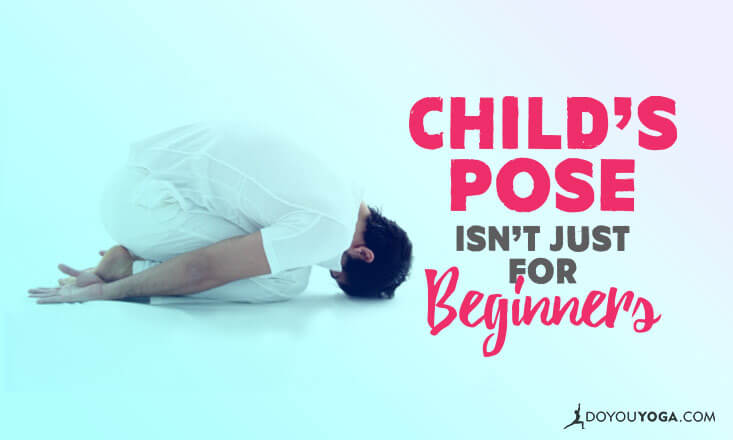Child’s Pose, or Balasana, is a resting posture and a place of relaxation and comfort in the yoga practice. This asana is frequently used as a point of restoration after difficult and tiring postures, allowing practitioners a moment to restore the rhythm of their breath and surrender into the moment.
Some advanced practitioners may frown upon Child’s Pose as a “beginner's” posture that holds no value or place in their practice. However, this thought could not be further from the truth.
Balasana is an important counter pose to many other asanas, and the benefits of this simple little asana are plentiful. This very grounding and nurturing posture is effective for many reasons, and should ideally be practiced by yogis of all skill levels.
Here are six verifiable reasons why Child’s Pose is definitely not only for beginners:
1. It Isn’t Really a Beginner’s Pose
Balasana is actually not a suitable posture for most beginner practitioners. This simple resting posture actually requires a great deal of flexibility. There is deep extension at the ankle joint as the toes point toward the back of the mat, and even greater extension at the knee joint (so this asana is contraindicated for those with knee injuries).
Furthermore, the posture mimics the action of the spine in a deep Forward Fold, creating a rounding of the lower back and a deep compression of the hip joints as the torso is drawn toward the thighs.
The stretching that occurs during the pose is subtle and gentle, but flexibility is a prerequisite to even enter the posture without support from props.
2. It’s a Gentle Stretch
Deeper is not always better. Often the body needs sufficient time and warm-up to prepare for deeper stretches regardless of how flexible a yogi may naturally be.
Child’s Pose is a wonderful asana to use toward the beginning of a practice (for beginners and advanced practitioners alike) to prepare the body for what lies ahead. Gently and slowly opening the hips, lower back, shoulders, neck, thighs, and ankles, Balasana is a beautiful full-body warm-up for any yogi’s practice.
3. It Aids Digestion
Balasana encourages you to breathe deeply into the belly and the back of the torso. The contact of your abdomen on your thighs literally allows you to feel the movement of the breath as your belly expands toward the legs with each inhale, and lifts away from them with each exhale.
This compression against the thighs quite literally creates a manual massage of the organs. And holding here for long enough while consciously taking deep breaths can help to aid your organs and digestive tract to help move things along.
4. It’s an Effective Counter Pose
In yoga, there are postures that move the body in one direction and then postures that counter that to move the body in the complete opposite direction to keep harmony and balance. Child’s Pose is used as an effective counter posture to many different poses in the practice of varying levels of difficulty.
Child’s Pose is widely recognized as an effective counter position to many inversions as it slows the heart rate after stimulation created by flipping upside down. It is also an operative counter pose to deep backbending (after a brief resting period allowing the spine to neutralize) as it creates flexion of the spine to equalize the extension of the back body that backbends produce.
Counter poses should never be skipped in a practice, regardless of the skill level of the practitioner, and Child’s Pose is a highly useful asana in your catalogue of counter poses.
5. Its Benefits Run Much Deeper Than Surface Level
Child’s Pose places your spine in the Primary Curve, the same curvature of the spine that exists in the womb (thus, creating feelings of safety and comfort). This position of the back body encourages blood flow and the transmission of nerve messages.
The Primary Curve also gently lengthens the nerves of the sympathetic nervous system that branches from the thoracic and lumbar regions of the spine (the middle and lower back, respectively) and the parasympathetic nervous system that branches from the upper spine and sacrum (the neck and the pelvic region, respectively). The lengthening of these systems creates greater mobility allowing the nerves to function more effectively.
Not only that, but Child’s Pose also creates contact between your forehead and the floor (or your fists, a block, a bolster, or a blanket). This contact with your forehead against something stimulates a branch of the vagus nerve (a key regulator of the parasympathetic nervous system) that runs through the forehead.
This stimulation is powerful enough to slow the heart rate, lower blood pressure, decrease tension, and decrease cortisol levels in the body.
6. It Reminds You to Find Balance in Your Practice
Many advanced yogis like to continuously challenge themselves on the mat, reaching toward harder and harder transitions, deeper and deeper postures, and stronger and stronger asanas. It is a beautiful thing to keep your practice growing and to continuously learn from your practice, both physically and mentally, but there comes a time when rest is an essential ingredient to your flow.
Balasana reminds you to find equilibrium on your mat — that sacred balance between effort and ease. Child’s Pose encourages you to take the time before or after challenging postures to relax, listen to your breath, and draw your attention inward. The softness of the posture in your body encourages softness of the mind and the simplicity of the pose reminds you of the simplicity of the breath.
Balasana is the perfect position to find balance for practitioners of all skills and levels — and isn’t finding balance exactly what draws you to your mat in the first place?
Why do you love practicing Child's Pose? Share with us in the comments below!


